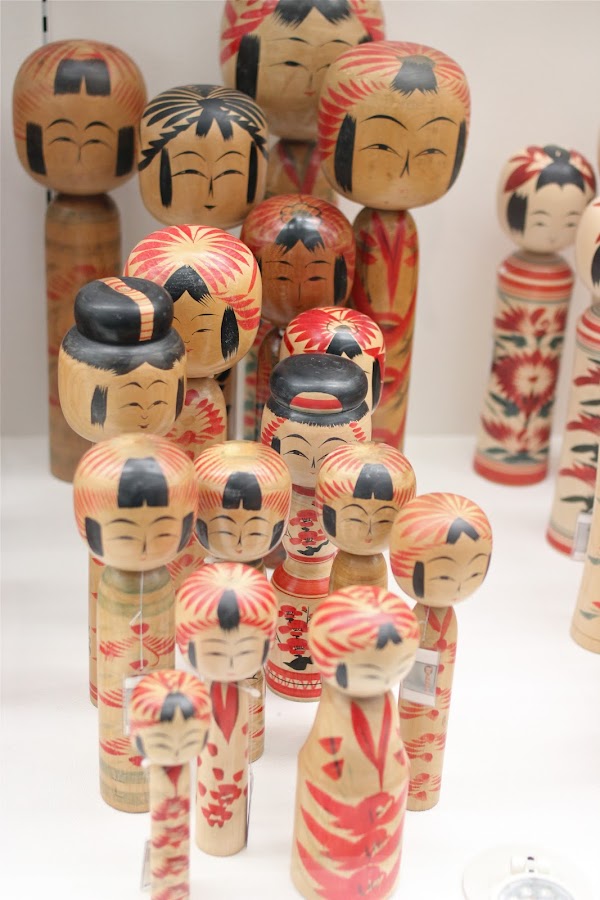While on holiday in Japan, I kept a detailed series of notes in
honour of Nanowrimo. All posts about Japan comprise excerpts from my
journals.
6th November, 2013
"Where the Baby Fish Aquarium made me feel giggly, the Yokohama Doll Museum makes me quiet. Contemplative, even. I wasn't expecting that. I'm not even sure what to expect of a doll museum. We only pick it because it sounds cool and is located in Motomachi Chukagai, a stroll away from Chinatown.
The sun is setting when we get there. I don't know what I'm bracing myself to see - Barbies, a row of Cabbage Patch kids - but what it really is, is a love song to toys and artforms throughout the ages.
The sun is setting when we get there. I don't know what I'm bracing myself to see - Barbies, a row of Cabbage Patch kids - but what it really is, is a love song to toys and artforms throughout the ages.
The museum, which is small but colourful and wonderfully organised, has dolls and toys from over a hundred different countries and from throughout the 19th century till now. The introductory panel tells us that Yokohama has a soft spot for dolls because the dolls from overseas, the West in particular, came in to Japan through Yokohama and at the same time, on a kind of friendship exchange programme, dolls from Yokohama went out to the rest of the world. This way, children from all over got to know each other vicariously. The friendship dolls apparently travelled on a special passport that cost one cent.
The array of toys is quite astounding. And every one has an individual identity and story. The Japanese used to make horses out of tightly twisted and packed straw. There are little reindeer on toothpick sized legs that peek out from forests of tiny trees. The horses from later years look more like Inuit art with graphic colours and prints. The Brazilian dolls are great fun, wearing fruit on their heads and real beaded necklaces of their own. The Korean dolls are pretty and slim with exquisite makeup and costumes but there are also a couple of older people, a grandfather and grandmother, sitting together and laughing.
One set of animals groups together playing instruments and baying with endearingly human looks on their lupine faces.
We find one set of dolls from my father's homeland and... well, I have to say, I'm not sure what's going on, Pakistan. You guys really need to lift your game.
The Mexican dolls have corn husk clothes, as do the dolls from one Scandinavian country and despite their monochromatic garb, both sets are deeply expressive. The Native American dolls are filled with intricate and heartbreaking detail and I start to realise that they are all about different aspects of life. An old woman carrying a bundle of twigs. A man struggling to prop a tuna on his shoulders. A hunter, coming home with the pelt of a deer in his hand. A woman at a loom, or feeding a baby.
We move further back into history with intricately made Japanese dolls and the "twice baked" Bisque dolls from France that started doll-making and owning crazes. There is one Bisque doll, a Miss Mettie McRoberts, who has her own trunk of clothes. In a separate room, we get to watch the doll-making process for a Japanese and Western doll. The processes are similar, molding and carving and delicate, slow brush strokes to paint eyelashes and red lips. It's absolutely fascinating.
Some of the dolls are immediately, intuitively exquisite. Some are strange, even a little grotesque but every single one of them was made lovingly for a reason, with a purpose in mind. Someone molded their limbs and curled their hair. Sewed them clothes. Carved their faces and painted in eyes. Some as religious effigies. Some, simply to be loved. I am suddenly deeply moved. We walk, quietly, respectfully from case to case admiring the workmanship and the effort. Maybe some time a long time ago, these were some child's dolls and drank from plastic teacups at plastic tea parties or comforted an insomniac ten-year-old.
The most haunting part of the museum is a timeline that stretches over two floors of dolls over the years. We walk down the line looking at pictures of people smiling with their dolls and cuddling them.
My mum points at a picture of toddlers in my dad's year. 1942. "They would all be in their seventies now," she says. We stand and look at them for a little while longer.
We decide to walk the three-something kilometres back to Minato Mirai, where we are staying. My head is full of things I've seen, of kindness and passion and good-humour and things being treated with respect. The sky is turning navy and all the little lights are winking in the harbour as runners, children, dogs head home. We walk to feel the wind on our faces, to see the sliver of a crescent moon climb slowly over the skyline.
My mum picks up a gingko leaf. Holds it in both hands and shows me how it fans out. We take a picture, throw the leaf to the wind.
A dog's bark carries on the air, over the slap of waves on the concrete of the canal. A particularly big swash creates a fine spray and two people leaning on the railing at the wrong time scream.
My mother shoves her hands in her pockets, looks at me and says, "I'm so glad to be here."
PS After our fake detox day, we are so starved we end up pigging out on a shitload of good ramen, gyoza and veggies. Righteous!"



































No comments:
Post a Comment
Say your peace, yo.